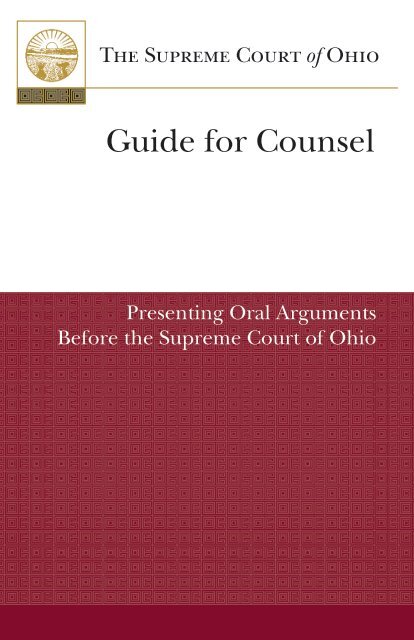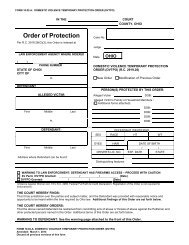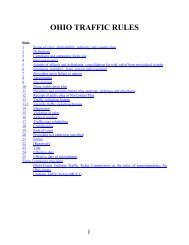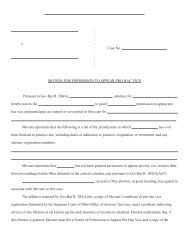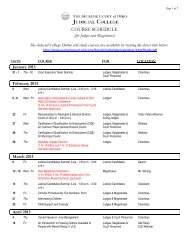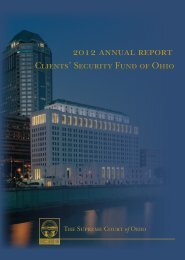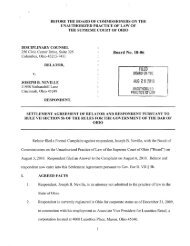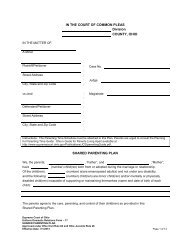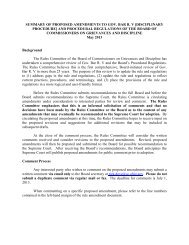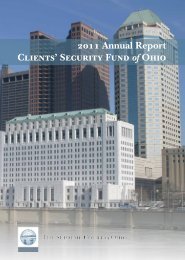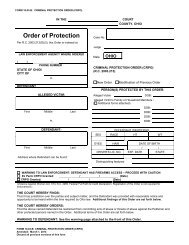guide for presenting oral argument - Supreme Court
guide for presenting oral argument - Supreme Court
guide for presenting oral argument - Supreme Court
Create successful ePaper yourself
Turn your PDF publications into a flip-book with our unique Google optimized e-Paper software.
This <strong>guide</strong> <strong>for</strong> counsel <strong>presenting</strong> <strong>oral</strong> <strong>argument</strong> isprepared by the clerk of the <strong>Supreme</strong> <strong>Court</strong> of Ohio, andis designed to assist attorneys preparing cases <strong>for</strong> <strong>argument</strong>be<strong>for</strong>e the court. It is not a substitute <strong>for</strong> the Rules ofPractice of the <strong>Supreme</strong> <strong>Court</strong>, which are available on thecourt’s website at www.supremecourt.ohio.govunder the clerk of court’s page.WHO MAY ARGUEAny attorney who plans to argue be<strong>for</strong>e the <strong>Supreme</strong><strong>Court</strong> of Ohio must be on record as one of theattorneys <strong>for</strong> the party or amicus curiae that theattorney represents. If counsel is uncertain whether he or shehas entered an appearance in the case, then counsel shouldcheck with the Office of the Clerk. Pursuant to Rule 2.01 of theRules of Practice of the <strong>Supreme</strong> <strong>Court</strong> of Ohio, only attorneyslicensed to practice in Ohio and attorneys admitted pro hacvice are permitted to <strong>oral</strong>ly argue a case.An amicus curiae that has filed a brief in a case is not entitled toparticipate in <strong>oral</strong> <strong>argument</strong> without leave of the court. Leavemay be sought by motion. This should be done well in advanceof <strong>oral</strong> <strong>argument</strong>, but in any event, no later than seven daysbe<strong>for</strong>e the <strong>argument</strong>.Any questions counsel may have about <strong>oral</strong> <strong>argument</strong> or aboutother case-related matters should be directed to the Office ofthe Clerk at 614.387.9530.
PREPARATIONCounsel may find it helpful to attend a session of courtbe<strong>for</strong>e the day scheduled <strong>for</strong> <strong>argument</strong>, or view asession on the court’s website. Oral <strong>argument</strong>s areusually held on Tuesdays and Wednesdays throughout the year,though the court typically schedules fewer <strong>argument</strong>s duringthe summer months. The schedule of <strong>argument</strong>s is posted onthe court’s website under the clerk of court’s page.In addition, all <strong>argument</strong>s presented since March 2004 arearchived <strong>for</strong> viewing on the court’s website.Counsel should anticipate questions that the justices might ask,and be prepared to answer them. If a case with similar issueswas argued recently at the court, counsel might want to watchthe archived video of the <strong>argument</strong>.ARRIVING AT COURTBetween 8:30 and 8:45 a.m. on the day of <strong>argument</strong>,arguing counsel must report to the deputy clerk atthe in<strong>for</strong>mation desk outside the <strong>Court</strong>room on thefirst floor of the Thomas J. Moyer Ohio Judicial Center. <strong>Court</strong>convenes at 9 a.m. Counsel can verify the order of <strong>argument</strong> atthat time, but should bear in mind that some cases concludeearlier than planned.If counsel is sharing <strong>argument</strong> time, counsel must advise thedeputy clerk about those arrangements and the amount of timethat each attorney intends to present <strong>argument</strong> (see ManagingTime, infra).Counsel should advise the deputy clerk of any necessaryaccommodations that counsel or guests may need (e.g., a2 THE SUPREME COURT OF OHIO
wheelchair or a hearing-assistance device). <strong>Court</strong> personnel canmake suitable arrangements to meet the request.After checking in, counsel may proceed to Room 103 or Room105 (Attorney Waiting Room), or enter the <strong>Court</strong>room andwait <strong>for</strong> his or her case to be called. Counsel may use personalcomputers and other electronic equipment in the waitingroom. A live audio feed from the <strong>Court</strong>room allows attorneys inthe waiting room to hear <strong>Court</strong>room proceedings as they occur.COURTROOM ETIQUETTECounsel should wear appropriate business attire befitting<strong>argument</strong> be<strong>for</strong>e the court.Counsel should also be aware that all <strong>argument</strong>s at the courtare televised live on the Ohio Channel, a cable channelsupported by Ohio’s public broadcasting stations, and arestreamed live on the court’s website.Personal computers and other electronic devices, such aslaptops and PDAs, may be used at counsel table. However,counsel should take steps to ensure that those devices donot create any visual or audio disturbance. Cellular phonesmust be turned off in the <strong>Court</strong>room, and audible alarms onwristwatches should be muted.When it is time <strong>for</strong> counsel to present <strong>argument</strong>, he or sheshould proceed to counsel table. Counsel <strong>for</strong> the appellantshould sit at the counsel table to the left of the bench as onefaces the bench. Counsel <strong>for</strong> the appellee should sit at thecounsel table to the right of the bench as one faces the bench.A GUIDE FOR COUNSEL PRESENTING ORAL ARGUMENTS 3
Additional attorneys who are affiliated with counsel <strong>presenting</strong><strong>argument</strong> may also be seated at each counsel table. Unless<strong>presenting</strong> <strong>argument</strong>, parties may not sit at counsel table.While seated at counsel table, counsel should remove the visitoridentification badge he or she was issued when entering thebuilding. Upon leaving the table at the conclusion of <strong>argument</strong>,counsel should clip the badge to his or her clothing again untilleaving the building.When the chief justice calls upon counsel, he or she shouldproceed promptly to the attorney lectern. Once the chiefjustice has finished speaking, counsel may open with the usualacknowledgement: “Chief Justice __________ and may it pleasethe court ….”Counsel should refer to the members of the court this way:“Justice ______” or “Your Honor.”Counsel should avoid referring to an opinion of the court bysaying: “In Justice ______’s opinion.” It is better to say: “In the<strong>Court</strong>’s opinion, written by Justice ______.”Counsel should avoid emotional oration and loud, impassionedpleas. The <strong>Supreme</strong> <strong>Court</strong> is not a jury. A well-reasoned andlogical presentation should be the goal of those <strong>presenting</strong><strong>argument</strong>.4 THE SUPREME COURT OF OHIO
PRESENTING ANEFFECTIVE ORAL ARGUMENTCounsel should assume that all of the justices have readthe briefs filed in the case, including amicus curiaebriefs. Ordinarily, counsel <strong>for</strong> the appellant need notrecite the facts of the case be<strong>for</strong>e beginning <strong>argument</strong>. Thefacts are set out in the briefs, and they have been read by thejustices.Argument should focus on the legal question or questions thatthe court has agreed to review. Counsel should avoid deviatingfrom them, and avoid arguing about the facts.Oral <strong>argument</strong> is a dynamic exchange of thoughts andin<strong>for</strong>mation between counsel and the court. To facilitate thisexchange, counsel should refrain from reading <strong>argument</strong> froma prepared script.In appropriate cases, counsel may suggest to the court thatbright-line rules should be adopted, and suggest what theyshould be. In many cases, the court must craft a sound rule oflaw that not only will resolve the case, but also will <strong>guide</strong> judgesand others in future cases.Counsel should avoid using the “lingo” of a business or activitythat is not widely understood. The court may not be familiarwith terms that are commonplace in a specialized area ofpractice. If necessary, counsel should explain unfamiliar termsso that the court can more easily follow the <strong>argument</strong> andunderstand the points being made.A GUIDE FOR COUNSEL PRESENTING ORAL ARGUMENTS 5
Counsel should be knowledgeable about what is and is notin the record in the case, and should be familiar with theprocedural history of the case. Justices frequently ask counsel ifparticular matters are in the record. It is helpful if counsel canprovide the volume and page where the in<strong>for</strong>mation is located.Counsel should avoid making assertions about issues or factsnot in the record. If counsel is asked a question that will requirereference to matters not in the record, counsel should beginhis or her answer by so stating, and then proceed to respond tothe question, unless advised otherwise by the justice.Unless counsel has complied with <strong>Supreme</strong> <strong>Court</strong> Practice Rule17.08, which allows one to file a list of additional authoritiesbe<strong>for</strong>e <strong>oral</strong> <strong>argument</strong>, counsel should refer during <strong>argument</strong>only to cases or other authorities that are listed in the merit orreply briefs.If counsel quotes from a document verbatim (e.g., a statute orordinance), he or she should tell the court where the text ofthe document can be read (e.g., “page ___ of the appellant’sbrief”).Counsel should know his or her client’s business. Justices maypose questions about how a product is made, how employeesare hired, or how a relevant calculation was made. Counselwho anticipates those kinds of questions and comes preparedto answer them in clear and simple terms will help the courtbetter understand the case.During <strong>argument</strong>, counsel should speak into the microphoneso that his or her voice will be audible to the justices, and toensure a clear recording.6 THE SUPREME COURT OF OHIO
RESPONDING TO QUESTIONSCounsel should expect questions from the court, andmake every ef<strong>for</strong>t to answer the questions directly. If atall possible, counsel should first respond either “yes” or“no,” and then expand on the answer. If counsel does not knowthe answer, an honest response is appreciated by the court.Counsel should avoid interrupting a justice when beingaddressed by the justice. Counsel should give full time andattention to the justice. If counsel is speaking when a justiceinterrupts, it is better to stop talking immediately and listen.If a justice poses a hypothetical question, counsel shouldrespond to the question in light of the facts stated in thequestion. Counsel should avoid saying, “But those are not thefacts in this case.” The justice posing the question is aware thatthere are different facts in the case, but wants and expects ananswer to the hypothetical question. Counsel should attemptto answer the question, and if necessary, may add an additionalcomment like: “However, the facts in this case are different,” or“The facts in the hypothetical question are not the facts in thiscase.”A justice will often ask counsel: “Do any cases from this courtsupport your position?” Counsel should be careful to cite onlythose cases that support his or her position and avoid distortingthe meaning of a precedent. If relying on a case that wasannounced by a plurality opinion, counsel should be sure tomention that there was no opinion of the court in the case.A GUIDE FOR COUNSEL PRESENTING ORAL ARGUMENTS 7
MANAGING TIMECounsel is not required to use all of the time allotted <strong>for</strong><strong>argument</strong>. If counsel has emphasized and clarified the<strong>argument</strong> in the briefs, and answered all of the court’squestions, counsel may consider completing the <strong>argument</strong>be<strong>for</strong>e time has expired.If counsel is sharing <strong>argument</strong> time pursuant to <strong>Supreme</strong> <strong>Court</strong>Practice Rules 17.05 and 17.06, counsel should in<strong>for</strong>m thecourt of the <strong>argument</strong> plan. For example, appellant’s counselmight say: “I will address the Fourth Amendment issue, andcounsel <strong>for</strong> the amicus will argue the Fifth Amendment issues.”Counsel should also in<strong>for</strong>m the deputy clerk of the intention toshare time when checking in (see Arriving at <strong>Court</strong>, supra).When counsel is sharing <strong>argument</strong> time with another attorneywho represents a different party on the same side of the case, ared light will activate when the first attorney’s time has expired.For example, assume that there are two appellants, and eachis represented by adifferent attorney. Ifthe first attorney onthe appellant’s side ofthe case has advisedthe deputy clerk thathe or she will argue<strong>for</strong> five minutes, thered light will activateafter five minutes haveexpired. That attorneymust then sit down.8 THE SUPREME COURT OF OHIO
When the marshal activates the yellow light, counsel should beprepared to stop <strong>argument</strong> in two minutes. (The yellow lightis used only <strong>for</strong> the last arguing attorney if two attorneys aresharing <strong>argument</strong> time.) The light signals that just two minutesremain of the total time allocated to your side of the case. (Forexample, if counsel has reserved three minutes <strong>for</strong> rebuttal, butthe light comes on during the initial presentation of appellant’s<strong>argument</strong>, counsel has already used one minute of rebuttaltime.)If counsel <strong>for</strong> the appellant has planned <strong>for</strong> rebuttal <strong>argument</strong>,counsel should tell the chief justice at the start of the <strong>argument</strong>how many minutes he or she intends to reserve <strong>for</strong> rebuttal.During <strong>argument</strong>, counsel should not ask the chief justicehow much time there is remaining. It is counsel’s obligation tokeep track of time. Time is displayed on a digital clock on theattorney lectern.When the red light comes on, counsel should end <strong>argument</strong>immediately and either request the chief justice to permit thecompletion of a point or sit down. If counsel is answering aquestion from a justice, he or she may continue answering andrespond to any additional questions from that justice or anyother justice. In that situation, counsel need not worry that thered light is on. However, counsel should not continue <strong>argument</strong>after the red light comes on. Once the chief justice announcesthat “the case is submitted,” counsel should promptly andquietly vacate the counsel tables in front of the bar.The allotted time <strong>for</strong> <strong>argument</strong> is consumed quickly, especiallywhen numerous questions come from the court. Counselshould be prepared to skip over much of his or her planned<strong>argument</strong> and stress the strongest points.A GUIDE FOR COUNSEL PRESENTING ORAL ARGUMENTS 9
COURTROOM PARTICIPANTSThe justices enter the <strong>Court</strong>room through an entrancebehind the bench. They sit in order of seniority with thechief justice in the middle, and the others alternatingfrom left to right, ending with the most junior justice on the farright as one faces the bench.The marshal sits at a desk to the left side as one faces thebench. The marshal calls the court to order, maintains decorumin the <strong>Court</strong>room, and times the <strong>oral</strong> presentations so thatattorneys do not exceed their time limitations.The attorneys scheduled to argue cases are seated at the tablesfacing the bench. The arguing attorney will stand behind thelectern immediately in front of the chief justice.OPINIONSThe court may release an opinion at any time after an<strong>argument</strong>, though opinions usually are released to theparties, the public, and the news media on Tuesdays,Wednesdays, and Thursdays at 9 a.m. All counsel of record willreceive a courtesy telephone call from the Office of the Clerkwhen the opinion in their case is released.Opinions are typically available on the court’s website as soonas they are announced. The Office of the Clerk or the Officeof Public In<strong>for</strong>mation can provide in<strong>for</strong>mation about opinionsonce they are released.10 THE SUPREME COURT OF OHIO
The <strong>Court</strong>room6 4 2 1 3 5 789101. Chief Justice O’Connor2. Justice Pfeifer3. Justice O’Donnell4. Justice Lanzinger5. Justice Kennedy6. Justice French7. Justice O’Neill8. Attorney Lectern9. Appellant Counsel Table10. Appellee Counsel TableA GUIDE FOR COUNSEL PRESENTING ORAL ARGUMENTS 11
DVM LOQVOR HORA FVGITAn engraving above the south <strong>Court</strong>room door remindscounsel in Latin that time flies as they speak.
December 2012
The <strong>Supreme</strong> <strong>Court</strong> of Ohio65 South Front Street Columbus, Ohio 43215-3431


